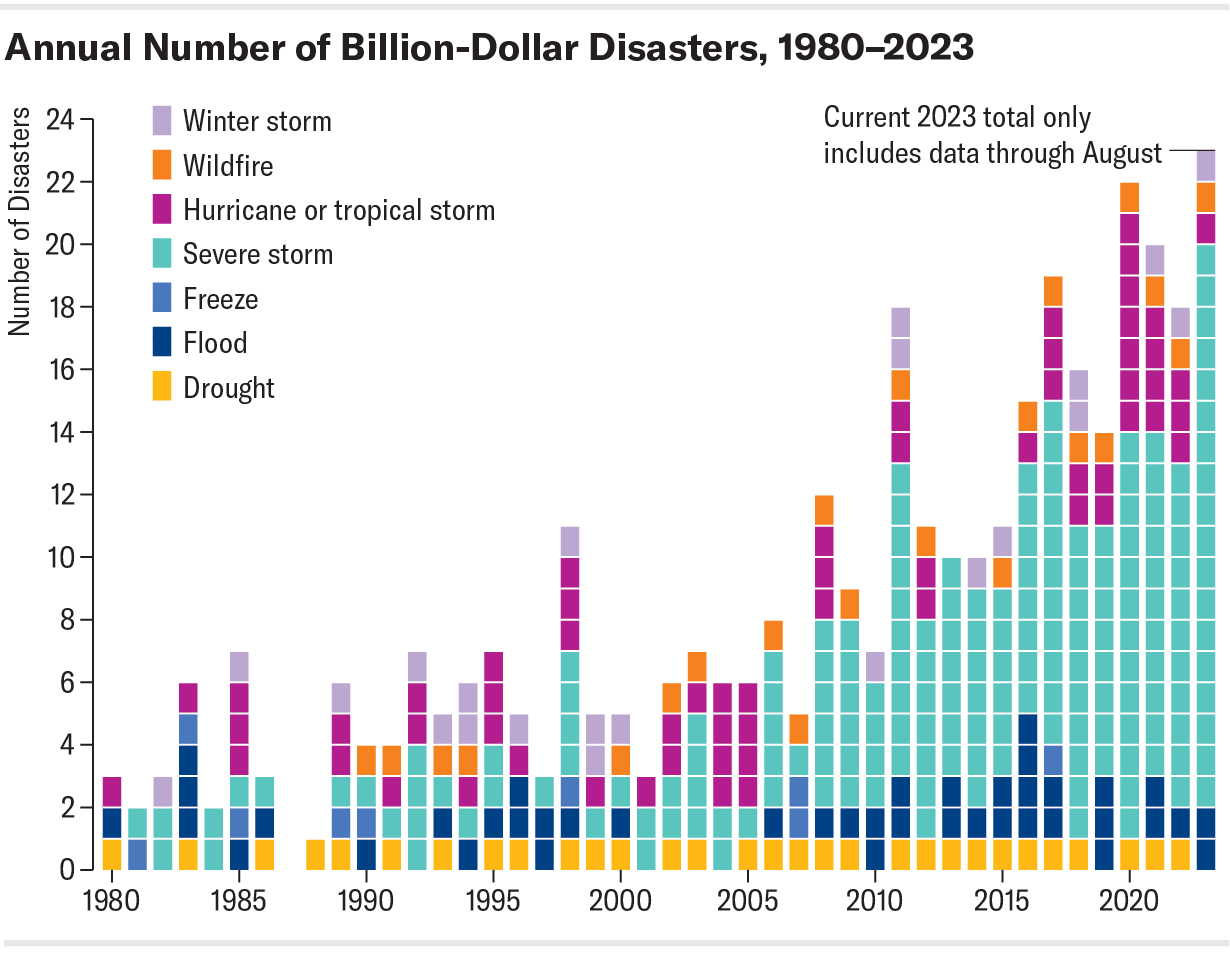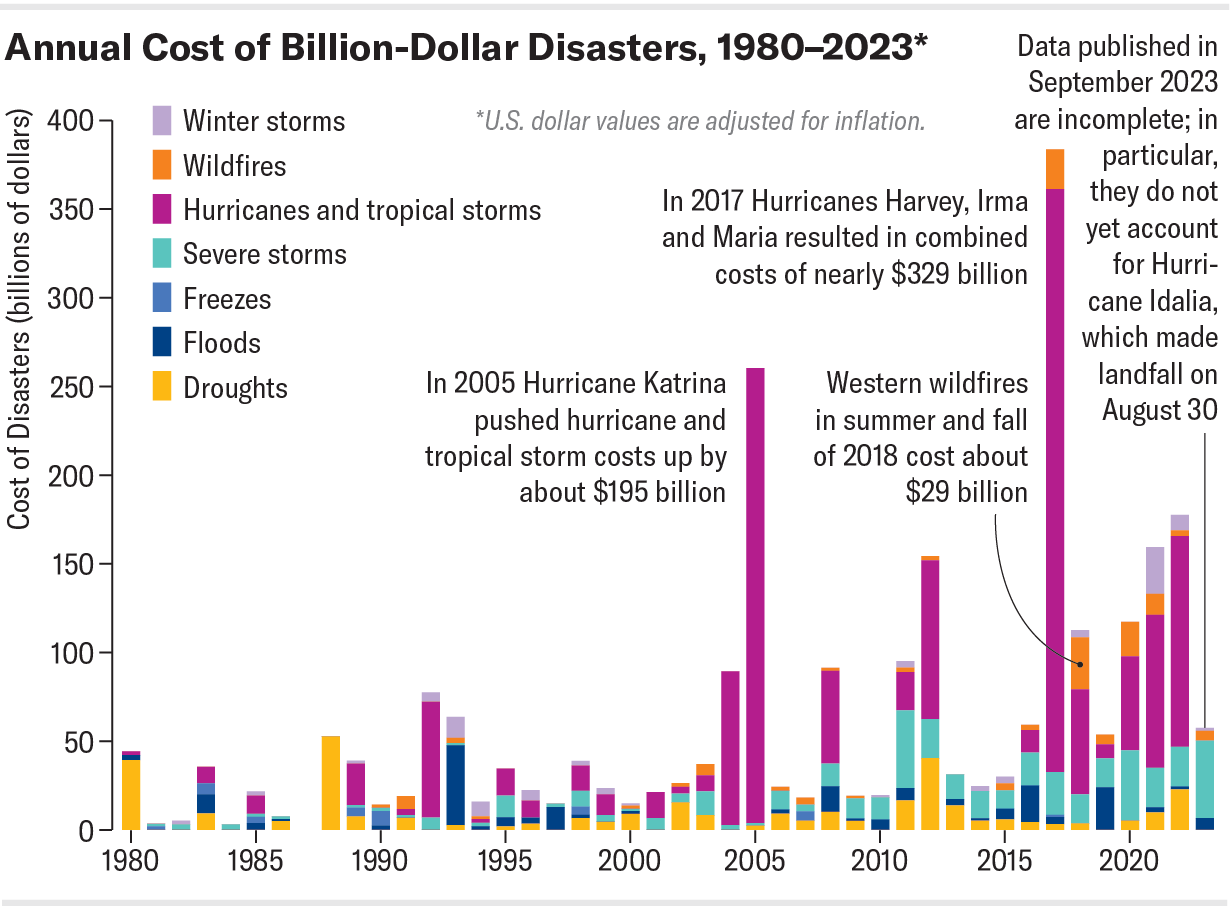By the end of this August, the U.S. had already set a new record for the annual number of billion-dollar disasters, which continues a trend toward more and costlier calamities occurring since the National Oceanic and Atmospheric Administration began tracking such data in the 1980s. At that time, a disaster causing at least $1 billion in damage hit the U.S. about every three months; now they happen about every three weeks, says Adam Smith, a NOAA climatologist who helps track the data.
And the costs of such disasters are almost certainly underestimates, underscoring how far behind the U.S. is in preventing and preparing for disasters at a time when climate change is exacerbating many of them. “It’s not a sustainable situation,” Smith says.
Through the end of August, NOAA’s tally showed 23 disasters that were confirmed to have cost at least $1 billion so far this year, which surpasses the record of 22 that was set in 2020. That latter number “shattered” the record of 16 events that happened in 2011 and in 2017, Smith says. He remembers thinking in 2017, “‘This record’s going to last for quite a while,’” only to be proven wrong just three years later.
Most of this year’s events involved severe weather that caused damage from hail, tornadoes, flooding and other impacts. One particularly costly and destructive disaster was the firestorm that destroyed the Hawaiian town of Lahaina; another was Hurricane Idalia, which caused substantial flooding in Florida, Georgia and other parts of the Southeast.

So far 2023’s disasters have cost more than $57.6 billion, but “that’s a starting point,” Smith says. That total doesn’t include damage costs from Idalia, which could add another $10 billion. More damage data from the other events could also continue to trickle in. Costs are estimated by compiling both uninsured and insured losses and encompassing a range of sources, from physical damage to buildings and other infrastructure to interruption to business. They don’t include health care costs or the costs associated with the loss of life, however, and are considered a conservative estimate. The current tally also leaves out two other crises for which damage estimates are still being determined and that could ultimately cross the $1 billion threshold: a continuing drought in the South and Midwest, and Tropical Storm Hilary, which caused substantial flooding across the Southwest.
One major type of disaster that is missing from any year in NOAA’s tracking is extreme heat. Several heat waves baked parts of the U.S. for weeks this summer and often broke records. Heat events can be difficult to tally because different areas have different heat thresholds—what counts as extreme heat in Portland, Ore., is different than in Phoenix, Ariz.—and the economic and other impacts are harder to directly link to such events. But Smith says NOAA is looking at how to potentially include heat in its tracking.
Another missing phenomenon is wildfire smoke, which became more of a national issue this year as smoke from fires in Canada repeatedly shrouded skies over the Northeast and Midwest. Wildfire smoke causes serious declines in air quality that have significant health impacts, as well as economic ones; outdoor work, such as construction, sometimes has to be halted.
The year 2017 still holds the record for total disaster costs, at more than $350 billion. That year’s wildfire season was an order of magnitude more expensive than average, and there were also three extremely damaging storms: Hurricanes Harvey, Irma and Maria. Behind 2017 is 2005, a year when costs were primarily driven by the catastrophic damage wrought by Hurricane Katrina. Total annual disaster costs have been more than $100 billion for five of the last six years. From 2016 through the present, disasters have cost the U.S. more than $1 trillion—more than one third of the total $2.6 trillion estimated for all disasters since 1980 (adjusted for inflation).
Taken together, the data paint a troubling picture of how far the U.S. lags behind in disaster preparedness. “The trends are really going in the wrong direction,” Smith says. “The data are talking, and we need to listen.”

Climate change is a key factor. For example, heavier rainfall contributed to more flooding disasters in the U.S. in the 2010s than in the previous three decades combined, Smith says. But human decisions such as where and how to build also play an important role. Hurricanes, which are among the costliest disasters on a per-event basis, hit in coastal areas where the U.S. has seen a surge in population—and a corresponding increase in new buildings and other infrastructure. Many parts of the country lack robust building codes, an oversight that can lead to very preventable damage and loss of life.
Investment in emergency management and disaster preparedness is “not even remotely keeping pace” with what the country faces each year, says Samantha Montano, an assistant professor of emergency management at Massachusetts Maritime Academy. In just one example, the Federal Emergency Management Agency’s disaster fund is close to running out of money without an emergency infusion of cash from Congress. This has forced the agency to pause its longer-term recovery efforts and focus only on immediate needs.
And when a disaster struck in decades past, there was generally more time to focus on recovery before the next crisis emerged. “That world just doesn’t exist anymore,” Montano says, and given current trends, “I don’t necessarily see a future where that exists for a while.”
She and other emergency management professionals have advocated for the creation of a bipartisan advisory committee that could make policy recommendations to Congress about how to revamp the nation’s emergency management apparatus and where to focus its funding. But so far nothing along those lines has materialized. Nor has there been any effort to come up with a comprehensive national climate adaptation plan, which could help harden communities to withstand more extreme climate-driven disasters. “There just is no plan” for how to handle increasing disasters, Montano says. “As far as I know, no one’s even trying.”


